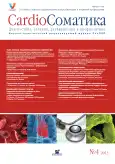Encephalopathy-causes of formation and their significance from the standpoint of factor analysis
- Authors: Starovoytova I.M1, Potekhin N.P2, Fursov A.N2
-
Affiliations:
- Russian Medical Academy of Postgraduate Education
- BurdenkoMain Military Clinical Hospital
- Issue: Vol 4, No 4 (2013)
- Pages: 45-50
- Section: Articles
- URL: https://journals.rcsi.science/2221-7185/article/view/45059
- DOI: https://doi.org/10.26442/CS45059
- ID: 45059
Cite item
Full Text
Abstract
Full Text
##article.viewOnOriginalSite##About the authors
I. M Starovoytova
Russian Medical Academy of Postgraduate Educationканд. мед. наук, доц. каф. мед. экспертизы
N. P Potekhin
BurdenkoMain Military Clinical Hospitalд-р мед. наук, проф., засл. врач России, зам. нач. ГВКГ им. Н.Н.Бурденко по мед. части
A. N Fursov
BurdenkoMain Military Clinical Hospital
Email: fursovan@mail.ru
д-р мед. наук, проф., засл. врач России, зав. отд-нием артериальных гипертензий Кардиологического центра ФГУ ГВКГ им. Н.Н.Бурденко
References
- Гусев Е.И., Скворцова В.И. Ишемия головного мозга. М.: Медицина, 2001.
- Дамулин И.В., Захаров В.В. Дисциркуляторная энцефалопатия: Методические рекомендации. Под ред. Н.Н.Яхно. М.: ММА, 2000.
- Скоромеец А.А., Скоромеец А.П., Скоромеец Т.А. Нервные болезни. Учебное пособие. М.: МЕДпресс - информ, 2005.
- Яхно Н.Н., Левин О.С., Дамулин И.В. Сопоставление клинических и МРТ-данных при дисциркуляторной энцефалопатии. Неврол. журн. 2001; 6 (2): 10–5.
- Лихтарман Б. Несуществующая болезнь. Итоги VI Международного конгресса по сосудистой деменции. Мед. газета. 2009; 98: 14–5.
- Ефремушкин Г.Г., Подсонная И.В. Артериальная гипертензия и дисциркуляторная энцефалопатия – что первично? КардиоСоматика. 2011; 4: 28–34.
- Ляпкова Н.Б., Потехин Н.П., Фурсов А.Н. Научные исследования в клинике: Руководство для врачей. М.: ГВКГ им. Н.Н.Бурденко, 2010.
- Одинак М.М., Михайленко А.А., Иванов Ю.С., Семин Г.Ф. Сосудистые заболевания головного мозга. Спб.: Гиппократ, 1997.
Supplementary files







